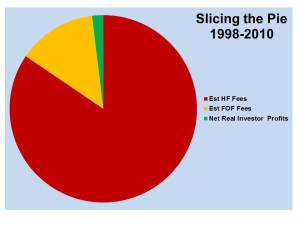In recent years as hedge fund performance has become ever less appealing, the industry has responded in part by changing the way it describes itself (much cheaper than cutting fees or delivering better results). So when Absolute Return outlived its utility, since many funds were unable to deliver positive returns in excess of treasury bills no matter how long they were given, some managers claimed that their objective was to deliver Relative Returns. That is, while their returns might not be positive they could be relatively better than other asset classes. This was a handy move prior to 2008, because returns were very definitely not positive but were less horrendous (i.e. relatively better) than equities.
More recently, Uncorrelated Returns has gained favor. This was another smart move just in time for 2011’s results, because while returns were definitely not positive (i.e. Absolute Return wouldn’t have been an appropriate moniker) or even relatively good (since they were worse than virtually anything else you could invest in) they were definitely uncorrelated. This could be a good long term choice, because uncorrelated just means they don’t have to look like anything else you own, which could encompass quite wide set of investment outcomes.
I just came across another term though, Smart Beta. This was used (for example) in an article from last year and although there is no photo of the author’s face when he wrote it I believe it is intended to be taken seriously. Perhaps it is meant to evoke Smart Bombs, which unerringly reach their target through computer driven guidance. In fact, bombs is a useful if unfortunate connection to use in this context.
But then everything was cleared up by Zilch Capital, a hedge fund that is evidently moving quickly from relative obscurity to complete oblivion and whose latest marketing letter was kindly reproduced in the Economist. Ah well, the hedge fund industry is a soft target. As Warren Buffet once said, if you don’t kick a man when he’s down when will you kick him? They’ve tried Absolute, Relative and Uncorrelated. Perhaps it should be the Zilch Return industry.



